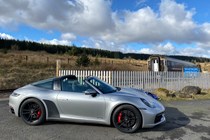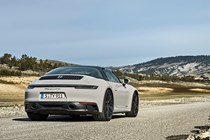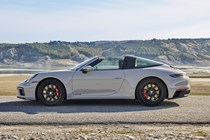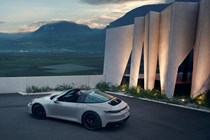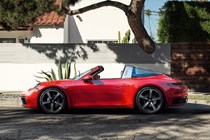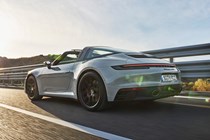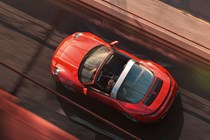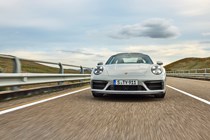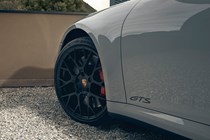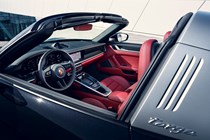
Porsche 911 Targa review

At a glance
| Price new | £113,055 - £159,655 |
|---|---|
| Used prices | £69,432 - £149,856 |
| Road tax cost | £600 |
| Insurance group | 50 |
Get an insurance quote with

|
|
| Fuel economy | 25 - 27.2 mpg |
| Miles per pound | 3.7 - 4.0 |
| View full specs for a specific version | |
Available fuel types
Petrol
Pros & cons
- Excellent low-speed manners
- Immense high-speed ability
- Peerless build quality
- Convenient, timeless open-air feel
- Automated roof feels overdone
- Access to luggage area restricted
- Can't view the glorious engine
- Options, as ever, expensive
Overview
Crossing the boundaries between the Porsche 911 Coupe and Cabriolet, the 911 Targa4 is a direct link to one of the most distinctive shapes in the 911’s history. Like the 1967 original, the roof over the front seats can be removed and the rear window is a bright, elegant wrap around design meeting a central roll hoop; unlike the original, the Targa panel retracts itself, with a spectacular show of engineering that lifts the whole rear window of the car up and over the back.
The 911 Targa 4’s biggest rival is, arguably, the 911 Cabriolet, but you might consider it if you’re looking at the open-topped versions of the Audi R8, Lamborghini Huracan or a pre-owned Ferrari California. Compared with the Cabriolet, the Targa retains most of the storage space beneath the rear window you would get with the 911 Coupe.
Although the 911 Targa 4 follows the Carrera range, it’s less diverse. You can have a Targa 4, a Targa 4S or a Targa 4 GTS as well as occasional special editions (such as the 50 Years Porsche Design), all of which share the basic layout of a turbocharged 3.0-litre flat-six engine mounted in the rear, and all-wheel drive. Not all models are equal, though, with 385hp to 480hp on offer across the range.
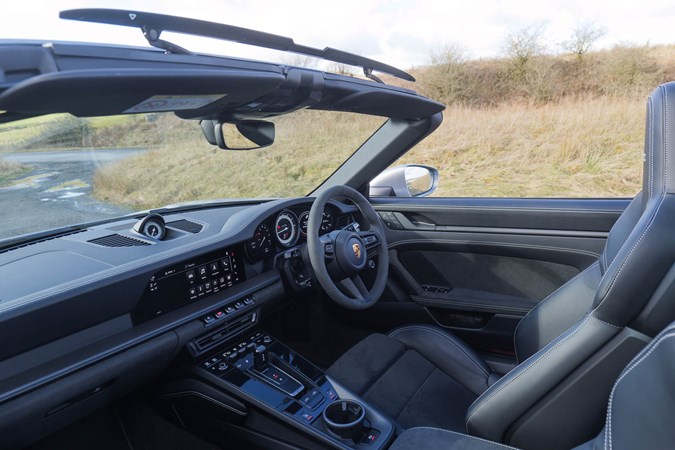
What’s it like inside?
Key to the 911’s enduring appeal has been the evolutionary approach for each new generation, and the 992 (to give it the Porsche type code) seeks to reinforce that heritage. As such, the dashboard is carefully styled to look as much like an original 911 as possible, reflecting the minimalist approach of the ‘60s but with modern technology. No two 911s will be identical – the options list is both expensive and extensive – but they are built around a foundation of a spacious, yet cosy cockpit with digital instruments flanking an analogue central rev counter, supportive, well-bolstered seats and a pair of rear seats beneath the roll hoop.
There’s a carpeted load area above the engine, which can be used for luggage if the roof is closed, and some well thought out, if cramped, storage in the doors, glovebox and centre console. Everything is finished to a high standard and intuitive to use, which sums up the Porsche experience overall – it’s not always flashy, but it almost invariably makes sense and works exactly as you’d expect it to.
Almost. The Targa 4’s unique roof design does have some quirks, which we’ll get to later.
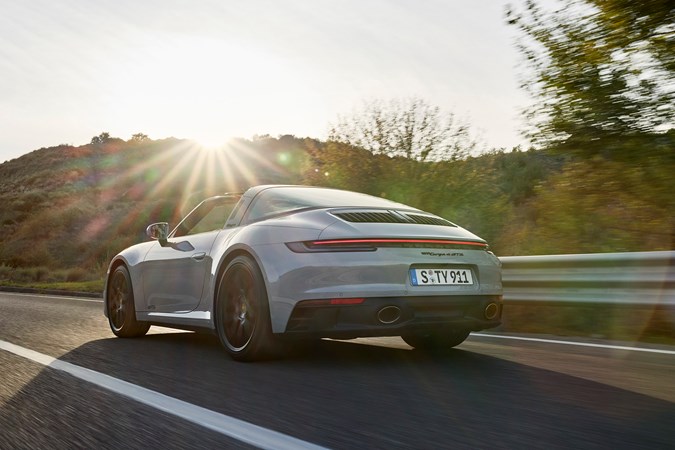
What it’s like to drive?
Porsche’s determination not to change the 911 too much means it is essentially a unique experience in a landscape of increasingly homogenous cars, and that’s before considering that ‘not all 911s are the same’. In the case of the Targa 4, it’s a secure, responsive car that drivers of all abilities should be able to jump into and enjoy without any anxiety that it’s going to be hard to control, or unduly tiring.
In fact, even the most powerful – the Targa 4 GTS — is thoroughly docile in nature when you first drive it. The engine’s subdued notes play behind you, and you can hear the metallic edge when passing buildings, but from the driver’s seat the car is comfortable, refined and very predictable. Despite the 911’s price and performance, it proved more relaxing on a six-hour drive than many luxury cars, and also delivered a little over 30mpg.
That’s not really the point of the 911 though, is it? You don’t need 450hp to drive at 70mph on a motorway. Throwing the comfortable, refined nature of this open-air GT into sharp relief is the experience you get when you switch into ‘Sport’ mode and find a track, or some challenging B-roads. Where many high-performance cars feel reigned in by speed limits, the 911’s lithe, communicative chassis and ample low-down torque make acceleration and grip just as delightful as speed, and it has more than enough of both. On track, that 191mph top speed is undoubtedly a joy, but on British roads this car is unusually deft and rewarding at a socially acceptable speed.

Supporting the pace set by the 3.0-litre twin-turbo and eight-speed automatic gearbox are steering and brakes that are weighted to perfection, with utterly predictable responses and the precision for accurate cornering without a twitchy, tiring straight ahead nature on long drives. If you enjoy driving, the 911 will make sense immediately.
For those of you looking at electric car performance and feeling the 911 GTS’ 3.5 second 0-62mph sprint isn’t all that impressive, it’s also worth noting that the power in reserve is available at higher speeds too for rapid, confident overtaking akin to a motorbike. Few, if any EVs can do that, including Porsche’s own Taycan.
For all that ability and those headline-grabbing stats, the beauty of the 911 Targa 4 is that it is just as enjoyable when relaxed. Discretion around town? Absolutely. Want to be seen? Open the exhausts and you’ll get that flat-six growl and a couple of exhaust blips before you reach 30mph, no hooligan tactics required.
With the roof in place the 911 Targa 4’s refinement is impressive, with the radio mostly fighting tyre noise. With the roof down, it’s a little noisier but the biggest drawback is that in cold weather the air is scooped and pushed into the front seats. It feels delightfully open, though, and when rain shows closes very quickly indeed.
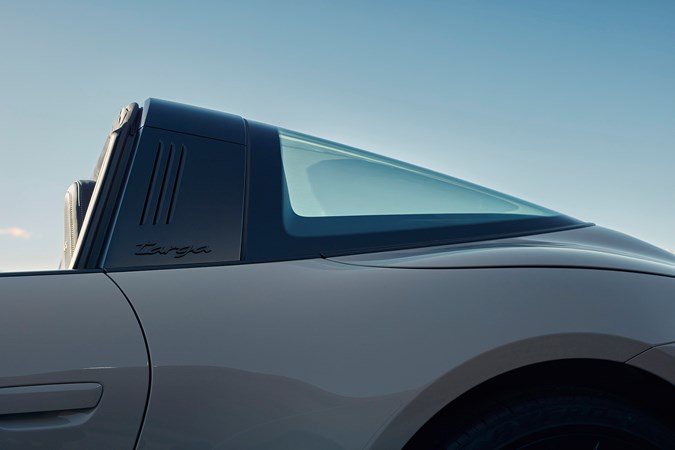
There are three versions of the Porsche 911 Targa 4. The ‘basic’ model has 385hp and will reach 62mph in 4.4 seconds with a top speed of 179mph, the 4S upgrades the power to 450hp, 3.8 seconds and 189mph and upgrades the brakes, making it arguably the one to go for rather than spending on upgrades to the 4, and the GTS turns it up a notch more with 480hp, 3.4s and 191mph – plus the cachet of the GTS badge.
Prices jump with each model, but you should compare the specifications carefully as each level includes upgrades beyond just the engine output. There’s a lot of scope for spending on interior trim and decorative upgrades as well as technology, and a Targa 4 with options can easily approach the cost of a 4S without any significant upgrade in ability.
What else should I know?
There are a couple of aspects of the 911 Targa 4 that car enthusiasts may not be fond of, and they all relate to the position of the engine. Or rather, the packaging needed to keep the car nimble and light with a lot of sophisticated technology.
First – you can’t look at that flat-six engine. It’s completely inaccessible, unlike mid-engined rivals where the powerplant is on show. All you can get to are oil and water level checks, and the bit that looks like an engine cover? That’s the adjustable spoiler.
Second – the Targa 4’s roof mechanism, which first appeared a decade ago on the 991 generation, is astonishingly complex to achieve the simple act of putting a small panel into the boot. It only operates at a standstill, and the entire rear window and surrounding bodywork arcs backward to then let a set of arms flip the roof into the boot. This mechanism means getting to the boot for luggage is equally convoluted, and yes, that’s also how you get to the engine’s levels. The car is beautiful, devastatingly competent and almost flawlessly engineered, but this arrangement over a lifting glass hatch and a manually-removed Targa panel seems redundant.
It does look very cool in operation, though.
Read our verdict to find out how highly we rate the Porsche 911 Targa.





